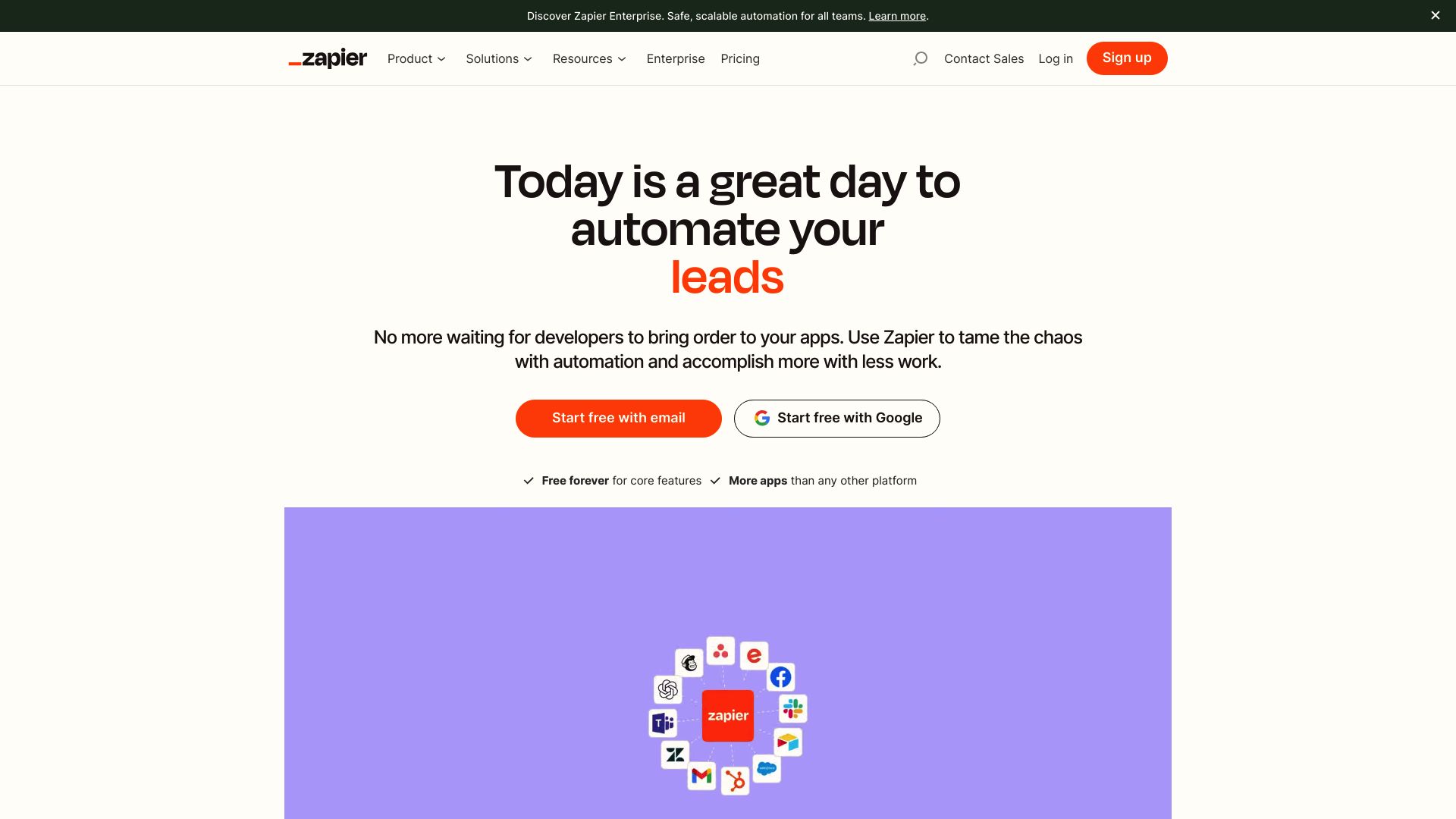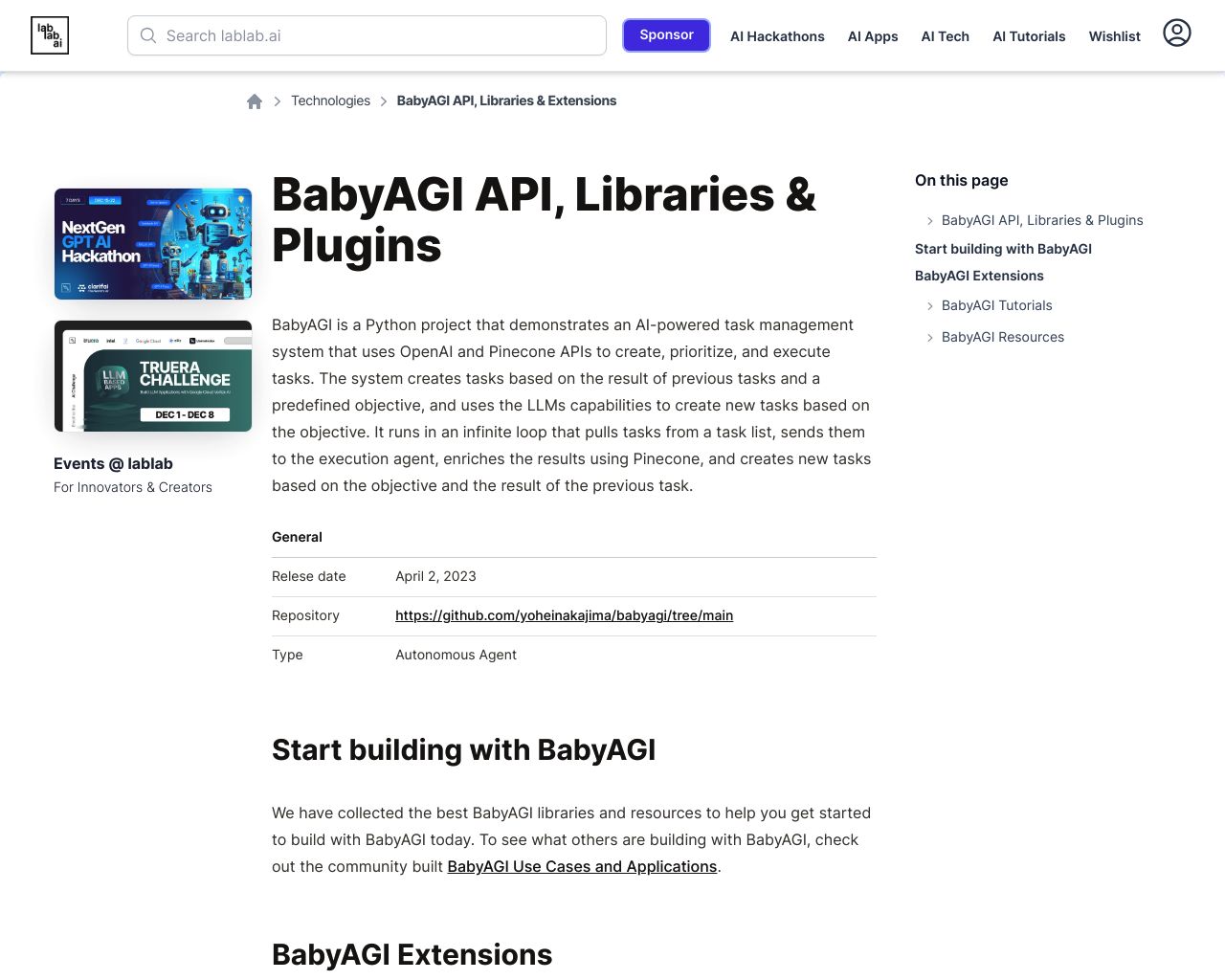Zapier vs. BabyAGI: AI Automation Showdown
AI-powered automation revolutionizes business processes, and three key players stand out: Zapier vs. BabyAGI, and SmythOS. Zapier connects thousands of apps for streamlined workflows, while BabyAGI pushes AI boundaries with human-like task management. SmythOS, however, combines the best of both worlds. This comparison explores how each platform tackles automation, integration, and AI capabilities. We’ll examine their strengths, limitations, and ideal use cases to help you choose the right tool for your automation needs. Whether you’re a developer seeking powerful APIs, a business leader focusing on scalability, or a non-technical user looking for no-code solutions, this guide offers insights to inform your decision and maximize productivity in today’s AI-driven landscape.
Zapier Overview
Zapier connects over 6,000 apps to automate workflows without coding. Users create “Zaps” — automated processes triggered by events in one app that perform actions in another. For example, a new email might automatically create a task or update a spreadsheet.
Zapier connects over 6,000 apps to automate workflows without coding. Users create “Zaps” — automated processes triggered by events in one app that perform actions in another.


Business users leverage Zapier’s visual builder to connect tools like Gmail, Slack, and Salesforce without writing code. Developers access more advanced options through Zapier’s CLI and API. The platform caters to individuals, small teams, and enterprises looking to streamline repetitive tasks.
Zapier offers both a user-friendly interface and developer tools. Its strength lies in its vast library of pre-built integrations. Users can quickly set up automations between popular business apps. However, Zapier lacks AI agent capabilities, focusing instead on rule-based automation.
Zapier offers both a user-friendly interface and developer tools. Its strength lies in its vast library of pre-built integrations.
While powerful for connecting existing apps, Zapier has limitations. It doesn’t support building conversational AI or autonomous agents. Complex workflows may require supplementary coding. Despite these constraints, Zapier remains a go-to solution for businesses seeking to boost productivity through app integrations and basic process automation.
BabyAGI Overview
BabyAGI represents a significant advancement in artificial intelligence, simulating human-like cognitive processes for task management. This open-source project, developed by Yohei Nakajima, aims to push the boundaries of AI by creating systems that learn and think similarly to humans.


BabyAGI’s core functionality revolves around autonomous task generation, prioritization, and execution. Unlike traditional AI systems focused on specific tasks, BabyAGI creates and manages a dynamic list of subtasks based on given objectives. The system continuously learns from previous tasks and adapts to new challenges, mimicking human adaptability.
BabyAGI creates and manages a dynamic list of subtasks based on given objectives. The system continuously learns from previous tasks and adapts to new challenges, mimicking human adaptability.
Leveraging advanced natural language processing capabilities from OpenAI and vector databases like Pinecone, BabyAGI ensures seamless task management. Its ability to generate new tasks autonomously, prioritize efficiently, and integrate memory and learning capabilities sets it apart from conventional AI tools.
BabyAGI’s task-driven autonomy and adaptability make it valuable across various fields, from customer service to healthcare and education. For example, in healthcare, it can analyze patient data and suggest personalized treatment plans, while in education, it can tailor learning experiences to individual students’ needs.
However, BabyAGI faces challenges common to open-source projects, such as the need for technical expertise to implement and maintain the system effectively. Users may need to invest time in understanding the underlying architecture and customizing it to their specific needs. Additionally, as an evolving project, it may lack some of the polished features and user-friendly interfaces found in commercial AI platforms.
Feature Comparison
Zapier and BabyAGI offer contrasting approaches to automation and AI task management. Zapier excels in app integration and workflow automation, connecting over 6,000 apps through its visual builder and API. It provides robust tools for creating rule-based automations between popular business applications without coding. However, Zapier lacks AI agent capabilities and autonomous decision-making features.
BabyAGI, on the other hand, focuses on simulating human-like cognitive processes for dynamic task management. It generates, prioritizes, and executes tasks autonomously based on given objectives. BabyAGI leverages advanced natural language processing and vector databases to continuously learn and adapt. Unlike Zapier, it offers problem-solving capabilities that mimic human adaptability across various fields.
While Zapier provides extensive integration options and a user-friendly interface for workflow automation, it falls short in areas like autonomous agents, memory and context retention, and AI-driven problem-solving. BabyAGI fills these gaps with its focus on cognitive simulation and adaptive task management, but lacks Zapier’s vast app integration ecosystem and polished user interface. SmythOS bridges this divide, offering both extensive integrations and advanced AI agent capabilities in a user-friendly package.
Feature Comparison Table
| Zapier | BabyAGI | SmythOS | |
|---|---|---|---|
| CORE FEATURES | |||
| AI Agents | ❌ | ✅ | ✅ |
| Hosted Agents (Dev, Production) | ❌ | ❌ | ✅ |
| Environments (Dev, Production) | ✅ | ❌ | ✅ |
| Visual Builder | ✅ | ❌ | ✅ |
| No-Code Options | ✅ | ❌ | ✅ |
| Memory & Context | ❌ | ✅ | ✅ |
| Autonomous Agents | ❌ | ✅ | ✅ |
| Explainability & Transparency | ❌ | ❌ | ✅ |
| Multimodal | ❌ | ✅ | ✅ |
| Problem-Solving Capabilities | ❌ | ✅ | ✅ |
| Multi-Agent Collaboration | ❌ | ✅ | ✅ |
| Human-AI Interaction | ❌ | ❌ | ✅ |
| Audit Logs for Analytics | ✅ | ❌ | ✅ |
| Agent Work Scheduler | ❌ | ❌ | ✅ |
| Logs & Monitoring | ✅ | ❌ | ✅ |
| SECURITY | |||
| Constrained Alignment | ❌ | ❌ | ✅ |
| IP Control | ❌ | ❌ | ✅ |
| COMPONENTS | |||
| Foundation AIs | ❌ | ❌ | ✅ |
| Huggingface AIs | ❌ | ✅ | ✅ |
| Classifiers | ❌ | ✅ | ✅ |
| Logic | ❌ | ✅ | ✅ |
| Data Lakes | ❌ | ❌ | ✅ |
| DEPLOYMENT OPTIONS (EMBODIMENTS) | |||
| Staging Domains | ✅ | ❌ | ✅ |
| Production Domains | ✅ | ❌ | ✅ |
| Deploy as Site Chat | ❌ | ✅ | ✅ |
| Deploy as Scheduled Agent | ❌ | ❌ | ✅ |
| Deploy as GPT | ❌ | ✅ | ✅ |
| DATA LAKE SUPPORT | |||
| Hosted Vector Database | ❌ | ✅ | ✅ |
| Sitemap Crawler | ❌ | ❌ | ✅ |
| YouTube Transcript Crawler | ❌ | ❌ | ✅ |
| URL Crawler | ❌ | ✅ | ✅ |
| PDF Support | ❌ | ✅ | ✅ |
| Word File Support | ❌ | ✅ | ✅ |
| TXT File Support | ❌ | ✅ | ✅ |
Best Alternative to Zapier and BabyAGI
SmythOS stands out as the superior alternative to Zapier and BabyAGI, offering a comprehensive platform for AI agent development and deployment. We combine the best of both worlds — Zapier’s integration capabilities and BabyAGI’s autonomous task management — while adding powerful features that set us apart.
Our drag-and-drop interface makes creating complex AI workflows accessible to users of all skill levels, without sacrificing advanced capabilities. Unlike Zapier’s rule-based automations, SmythOS empowers you to build truly intelligent agents that can make decisions, solve problems, and adapt to new scenarios. And while BabyAGI focuses on simulating cognitive processes, we provide a complete ecosystem for developing and deploying practical AI solutions across your organization.
SmythOS stands out as the superior alternative to Zapier and BabyAGI, offering a comprehensive platform for AI agent development and deployment.
SmythOS shines in its versatility and ease of use. Our platform supports a vast array of AI models, APIs, and data sources, allowing you to create agents tailored to your specific needs. Whether you’re building a customer service chatbot, an autonomous data analyst, or a multi-agent system for complex task management, SmythOS provides the tools and flexibility to bring your vision to life. Our visual builder and pre-built components eliminate the need for extensive coding, making advanced AI accessible to business users and developers alike.
We’ve also addressed key limitations of both Zapier and BabyAGI. Unlike Zapier, SmythOS offers robust memory and context retention, allowing your agents to maintain coherent, long-running interactions. And while BabyAGI lacks a polished interface and deployment options, we provide a complete suite of tools for developing, testing, and deploying your AI agents across various platforms and environments. With features like our Agent Work Scheduler and comprehensive logs and monitoring, we give you unprecedented control and visibility into your AI operations.
By choosing SmythOS, you’re not just getting a tool — you’re gaining a partner in your AI journey. Our platform grows with your needs, offering scalability and enterprise-grade features that support your organization’s evolution. From startups to large enterprises, SmythOS empowers you to harness the full potential of AI, driving innovation and efficiency across your business operations.
Conclusion
Zapier, BabyAGI, and SmythOS each offer unique approaches to automation and AI task management, but SmythOS emerges as the superior choice for businesses seeking comprehensive AI solutions.
Zapier excels in connecting popular apps and automating simple workflows without coding. Its vast library of pre-built integrations makes it accessible for non-technical users. However, Zapier lacks advanced AI capabilities and autonomous decision-making, limiting its potential for complex problem-solving.
BabyAGI pushes the boundaries of AI with its focus on simulating human-like cognitive processes. Its ability to generate, prioritize, and execute tasks autonomously shows promise for fields like healthcare and education. Yet, as an open-source project, BabyAGI requires technical expertise to implement effectively and may lack the polished features of commercial platforms.
SmythOS combines the best of both worlds, offering extensive integrations like Zapier and advanced AI capabilities like BabyAGI, all within a user-friendly package. Our platform stands out with its intuitive drag-and-drop interface, support for multiple AI models, and versatile deployment options. SmythOS empowers users to create sophisticated AI agents without extensive coding knowledge, making it ideal for businesses of all sizes.
If you’re ready to revolutionize your workflow with AI, explore our diverse range of AI-powered agent templates to jumpstart your journey. For those eager to dive deeper, our comprehensive documentation provides invaluable insights into SmythOS’s capabilities. Take the first step towards AI-powered success by creating a free SmythOS account and experience the future of workforce automation today.
Last updated:
Disclaimer: The information presented in this article is for general informational purposes only and is provided as is. While we strive to keep the content up-to-date and accurate, we make no representations or warranties of any kind, express or implied, about the completeness, accuracy, reliability, suitability, or availability of the information contained in this article.
Any reliance you place on such information is strictly at your own risk. We reserve the right to make additions, deletions, or modifications to the contents of this article at any time without prior notice.
In no event will we be liable for any loss or damage including without limitation, indirect or consequential loss or damage, or any loss or damage whatsoever arising from loss of data, profits, or any other loss not specified herein arising out of, or in connection with, the use of this article.
Despite our best efforts, this article may contain oversights, errors, or omissions. If you notice any inaccuracies or have concerns about the content, please report them through our content feedback form. Your input helps us maintain the quality and reliability of our information.
